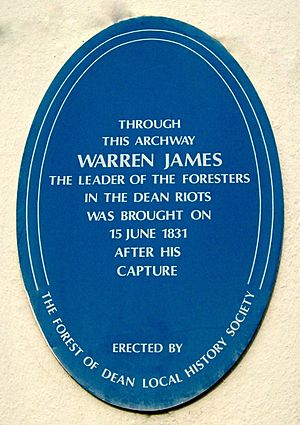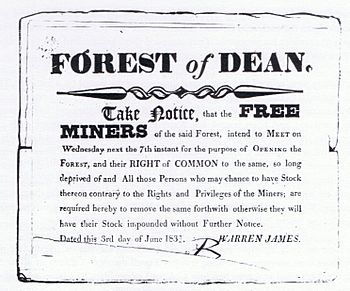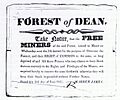Warren James facts for kids
Quick facts for kids
Warren James
|
|
|---|---|
| Born | July , 1792 Parkend, Forest of Dean
|
| Died | 26 October 1841 Hobart, Australia
|
| Resting place | The Parish of Trinity, Hobart, Australia |
| Occupation | Miner |
| Known for | Miners' leader during the Dean Forest Riots |
Warren James (1792–1841) was a famous leader of protests in the Forest of Dean, England.
As the Industrial Revolution brought big changes, the King's government wanted to change old rules about mining. They also wanted to let anyone buy and sell land and resources in the Forest of Dean. In 1808, the government decided to fence off large parts of the forest. This was to grow trees for building ships.
Local people, called Foresters, found it hard to compete with big companies from outside. They also lost their old rights to gather wood or let animals graze in the fenced-off areas. Many Foresters became very poor. People grew angry, and Warren James became a leader who spoke for the common people.
In 1831, he led a group of up to 3,000 Foresters in a big protest against the King's government. They pulled down about 60 miles of fences to try and get their land back. Warren James was put on trial and sentenced to death. However, this was changed to being sent to Tasmania as a punishment. He was forgiven five years later, but he could not afford to come back home. He died in Hobart in 1841. His actions have inspired many other campaigns. He is still one of the most important figures in the history of the Forest of Dean.
Contents
Warren James' Early Life
Warren James' father, also named Warren James (1751–1809), married Ann Kear (1755–1836) in 1777. They first lived in a rented house in Bream. In 1782, they moved to a small house they had built on land between Parkend and Whitecroft.
A map from 1787 shows their family home on the south side of Parkend. It was a "Turf" cottage, built on land that wasn't officially theirs. The King's government valued it at 15 shillings per year. Warren James (the younger) was born in July 1792. He was baptized at Bream Chapel on July 29, 1792. He was the sixth of nine children in his family.
Warren James likely did not go to school. However, later papers show that he could read and write as an adult. Like his six brothers, he started working as a miner at a young age, following his father.
His family was very poor. Their small houses were often built illegally from loose stones and covered with turf. They usually had no windows, just a low door, a simple fireplace, and a stone floor. The authorities could destroy their home at any time. In 1813, when James was about 20 or 21, his house was destroyed. The family was removed from the land, which was then used for growing trees. James moved with his mother to Bream. He never married.
Why the Dean Forest Riots Happened
The Forest of Dean has many natural resources. These include timber (wood), coal, and iron ore. People had been using these resources in small ways since before Roman times. But the King's government saw a chance for much larger mining and logging.
Local miners had special "free-mining" rights since at least 1244. But there were often arguments between the King's government and the Foresters about these rights. For example, in 1612, the Earl of Pembroke tried to fence off large parts of the forest. The Foresters took him to court and won. There were also earlier protests, like in 1631, when Sir Giles Mompesson built three new coal mines.
As the Industrial Revolution grew, the King's government wanted to bring in new rules. They wanted to allow outside companies to own land and mining rights in the forest. First, they made the old "Mine Law Court" illegal in 1777. They also destroyed the documents that held the laws by which the local miners governed themselves. Soon, big companies from outside started opening large iron and coal mines. The local Free Miners found it hard to compete. Often, they ended up working for these new owners for wages.
In 1808, the government passed a law called the Dean Forest (Timber) Act. This was because there was a big shortage of wood for building ships. This law said that 11,000 acres (about 4,452 hectares) of the forest would be fenced off. Edward Machen, a new deputy surveyor, was in charge of this. He set up his office in Parkend. By 1816, all 11,000 acres had been fenced off.
Ordinary Foresters were already very poor. Now, their situation became even worse. They could not go into the fenced-off areas. This meant they could not hunt or gather wood. Most importantly, they lost their old rights to let animals graze and to mine in these areas. People grew more and more upset. At first, there was no organized protest. Foresters had been told the fences would be removed after 20 years, once the oak trees were big enough.
In 1828 and 1829, the Foresters asked for the fences to be removed, but their request was denied. In 1830, a group called the "Committee of Free Miners" chose Warren James to speak for them in London. James sent a petition to the House of Commons on June 11, 1830, asking for the fences to be removed. But nothing came of it.
After more attempts to remove the fences failed, James finally called the Free Miners to action. A notice, dated June 3, 1831, was shared. It told Free Miners to meet the following Wednesday "for the purpose of opening the Forest." James and Edward Machen knew each other well. They both went to church regularly in Parkend. On Sunday, June 4, they held a public meeting outside the church gates. It was a last try to solve the problem peacefully, but they could not agree.
The notice said to meet on "Wednesday next the 7th instant." Wednesday was actually the 8th. But it was on the 8th of June that they met.
The Protests Begin
Edward Machen met James at Park Hill enclosure, between Parkend and Bream. But James was leading a group of over 100 Foresters. They started to pull down the fences there. Machen and about 50 unarmed Crown Officers could not stop them. Machen went back to Parkend and sent for soldiers.
On Friday, 50 soldiers arrived from Monmouth. But by then, the number of Foresters had grown to over 2,000. The soldiers went back to their barracks. By Saturday night, almost all the fences in the forest were gone. But the next day, a group of heavily armed soldiers arrived from Doncaster. The day after, another 180 soldiers arrived from Plymouth.
The Foresters' protest soon ended. Most of them went back into the forest and returned home. Warren James was arrested. He was sent to trial at Gloucester Assizes on Monday, August 13, 1831.
Warren James' Trial

Machen was the main witness at the trial. He talked about the notice James had put out. He also said he had put out his own notice, warning that such actions were illegal. He spoke about his meeting with James on Sunday. He said James claimed to have a document proving the fences were against the law. Machen then said that on Wednesday morning (the day of the protest), he went to James' house. He asked James to show him the document. James replied that it was inside his house. He then came back "with a pick axe on his shoulder."
Machen then described how he and another official followed James to the enclosure at Park Hill. He said he warned James again. He also said James made the first "blow" to the fence. Finally, Machen said he read the Riot Act. After hearing from several more witnesses, the jury found James guilty. But they asked for mercy because of his good character before this event.
The judge, Mr. Justice Patteson, sentenced James to death. But within two weeks, this was changed to being sent away for life. James was sent to Van Diemen’s Land, which is now Tasmania.
Of the other people arrested, one more was also sentenced to death. This was also later changed to being sent away. Nine people were sent to prison for up to two years. Several others received shorter sentences or fines. About a hundred others chose to rebuild the fences themselves instead of being charged with rioting.
Life in Australia
Conditions on ships that carried prisoners were very bad. Prisoners often died during the journey. James arrived in Tasmania on February 14, 1832. He was assigned to a work group that helped the Public Works Department in Hobart.
It seems he stayed out of trouble for four years. But on January 19, 1836, he was sentenced to a week in prison. This was for "neglect of duty and disrespect to a magistrate." Then, on February 24, 1836, he was given thirty-six lashes (a whipping). He was sent to work in a coal mine near Port Arthur. This was for "great disrespect towards the commandant when speaking to the prisoners."
Meanwhile, back in the Forest of Dean, the Foresters, with Machen's help, had been asking for James to be forgiven. This was granted on February 16, 1836. But the news did not reach James until September 13. He was not given a free trip home.
James decided to stay in Van Diemen's Land. We don't know why for sure. He probably could not pay for the trip home. By then, he was also in poor health. It also seems he had lost touch with his family and friends. He had no contact with them since leaving England.
James died in rented rooms in Argyll Street, Hobart, on October 26, 1841. His landlord, William Overell, gave a sad account of James' last few days at the official investigation. He described James' terrible condition. He also said James had refused medical help. The official record said James died from "Atrophy of the belly" and "very acute inflammation of the liver."
What Warren James Looked Like
There are no photos of James. But a prison document describes him when he was about 40 years old:

- Height: 5 feet 3 inches
- Skin: Dark
- Head: Round
- Hair/Whiskers: Black to grey
- Face: Oval
- Forehead: Long, sloping back
- Eyebrows: Brown
- Eyes: Hazel
- Nose: Sharp
- Mouth: Large
- Chin: Medium
- Notes: Stout (meaning a bit heavy or strong)
The same document said he was 30 when he arrived in Tasmania. But he was actually 40. This might mean he looked younger than his age.
Images for kids





